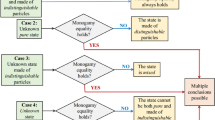Abstract
In the context of discussions about the nature of ‘identical particles’ and the status of Leibniz’s Principle of the Identity of Indiscernibles in Quantum Mechanics, a novel kind of physical discernibility has recently been proposed, which we call witness-discernibility. We inquire into how witness-discernibility relates to known kinds of discernibility. Our conclusion will be that for a wide variety of cases, including the intended quantum-mechanical ones, witness-discernibility collapses extensionally to absolute discernibility, that is, to discernibility by properties.
Similar content being viewed by others
References
Arenhart, J.R.B. (2012). Many entities, no identity. Synthese (to appear).
Caulton, A., Butterfield, J. (2012). On kinds of indiscernibility in logic and metaphysics. British Journal for the Philosophy of Science 63, 27–84.
Dieks, D., Versteegh, M.A.M. (2008). Identical quantum particles and weak discernibility. Foundations of Physics 38, 923–934.
French, S., Krause, D. (2006). Identity in physics: A historical, philosophical and formal analysis. Oxford: Clarendon Press.
Jantzen, B.C. (2011). No two entities without identity. Synthese 181, 433–450.
Ladyman, J., Bigaj, T. (2010). The principle of the identity of indiscernibles and quantum mechanics. Philosophy of Science 77, 117–136.
Ladyman, J., Bigaj, T. (2011). Private communication by e-mail, 2011.
Ladyman, J., Linnebo, Ø., Pettigrew, R. (2012). Identity and discernibility in philosophy and logic. Review of Symbolic Logic 5.1, 162-86.
Muller, F.A. (2011). How to defeat Wüthrich’s Abysmal embarrassment argument against space-time structuralism. Philosophy of Science 78, 1046-1057.
Muller, F.A., Saunders, S.W. (2008). Discerning fermions. British Journal for the Philosophy of Science 59, 499–548.
Muller, F.A., Seevinck, M.P. (2009). Discerning elementary particles. Philosophy of Science 76, 179–200.
Quine, W.v.O. (1976). Grades of discriminability. Journal of Philosophy 73, 113–116.
Saunders, S. (2003). Physics and Leibniz’s principles. In: K. Brading, E. Castellani (eds.), Symmetries in physics: Philosophical reflections. Cambridge: Cambridge University Press, 2003: 289–307.
Saunders, S. (2006). Are quantum particles objects? Analysis 66.1, 52–63.
Acknowledgments
We want to thank two anonymous referees for some helpful remarks, and J. Ladyman, T. Bigaj and the members of the Bristol Structuralism Seminar for conversations on the subject-matter. Øystein Linnebo was supported by an ERC Starting Grant.
Author information
Authors and Affiliations
Corresponding author
Rights and permissions
About this article
Cite this article
Linnebo, Ø., Muller, F.A. On Witness-Discernibility of Elementary Particles. Erkenn 78, 1133–1142 (2013). https://doi.org/10.1007/s10670-012-9385-4
Received:
Accepted:
Published:
Issue Date:
DOI: https://doi.org/10.1007/s10670-012-9385-4




